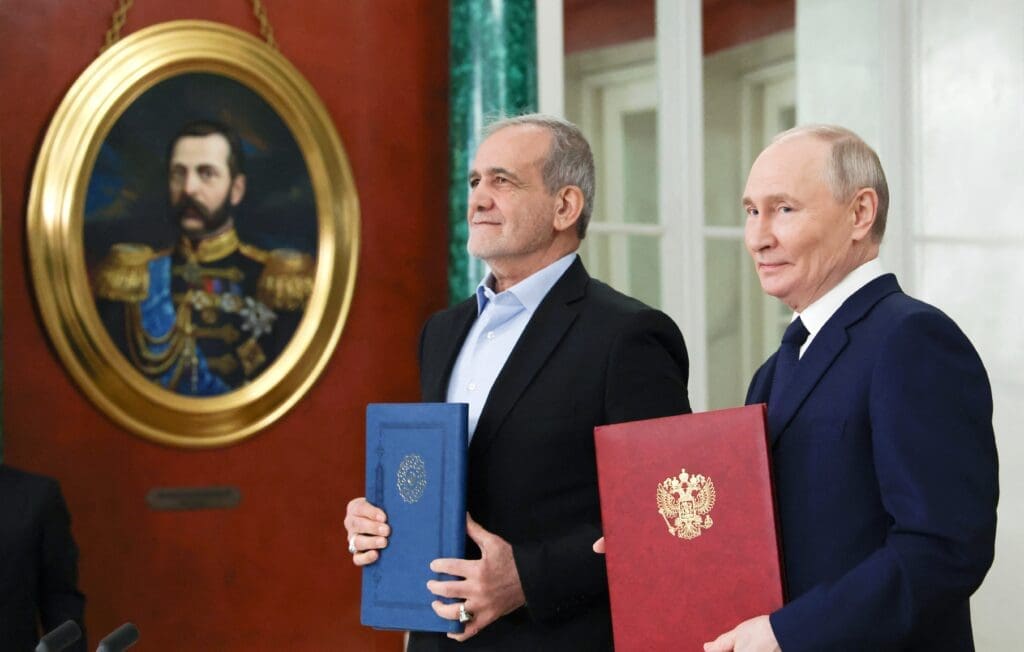On January 17, the presidents of Iran and Russia met in Moscow to sign a 20-year “comprehensive strategic partnership treaty.” The agreement, which focuses primarily on enhancing trade and security cooperation, comes as each country indirectly confronts the United States in conflicts with Ukraine and Israel, and on the heels of the abrupt toppling of their mutual ally Bashar al-Assad in Syria. Indeed, while the signing of the document may have been delayed by the collapse of the Assad regime in December, its eventual conclusion three days before U.S. President Donald Trump’s inauguration was likely no coincidence. To an American audience, it fed the narrative of an alternative alliance defying the U.S. Frederick Kempe, president of the Washington-based Atlantic Council, even referred to it as an “inaugural gift” for Trump.
Yet the implications are much larger than the narrative in Washington. As Iran seeks to recover from the military setbacks it incurred in 2024, Moscow’s closer engagement with Tehran could shape that process in ways that would have major consequences for Middle East security, especially on the Arabian Peninsula, and for nuclear proliferation.
From an American Vantage Point
In Washington, the rapprochement is being interpreted by some as part of an emerging alliance between a “quartet of chaos” made up of North Korea, China, Russia and Iran. Central to this narrative is these countries’ support for Russia’s war in Ukraine. From this viewpoint, the agreement with Iran follows strategically from one that Russia signed with North Korea in June 2024, similarly titled a “comprehensive strategic partnership.”
This framing can be misleading, however, as it fails to capture Russia’s engagement with Iran on its own terms. The warming of ties really began in Syria in the 2010s, as both sides deployed parts of their militaries to keep Assad in power during more than a decade of civil war. Throughout this period, Russian and Iranian operatives coordinated their efforts and deepened their influence in Damascus.
Over the past two years, the war in Ukraine accelerated the rapprochement. While North Korea has provided artillery and troops to the Russians, Iran has been instrumental in replenishing Russian firepower capabilities with unmanned aerial vehicles and ballistic missiles. This played an essential part in the intensification of airstrikes against Ukrainian cities in 2023.
The nature of these ties reveals how much Iran—and specifically the Islamic Revolutionary Guard Corps (IRGC)—has built a substantial inventory of drones and missiles, which is only inferior to Israel and Türkiye in the Middle East. But, perhaps more importantly, it also highlights the operational shortcomings of the Russian military, which increasingly relies on regional partners like Iran and North Korea to compensate for its shortages.
The latest accord builds on this cooperation by establishing a framework for the next two decades. According to public reports, the military component of the agreement will include strategic consultations on common security threats, joint military exercises and defense-industrial cooperation. Although the document and official statements did not specify the details of these initiatives, this strongly indicates that the Russia-Iran rapprochement is more than just a marriage of convenience limited to Syria and Ukraine; it reflects a real commitment from both to coordinate their security policies.
As such, Iran’s foreign minister, Abbas Araghchi, called the treaty “not just a political agreement” but “the road map to the future.”
Red Sea Insecurity
Cooperation between Iran and the Houthi insurgency in Yemen has also appeared to deepen over the past year. Following the outbreak of the Gaza crisis in October 2023, the Houthis steadily escalated their missile and drone attacks on ships crossing the Red Sea. Although the group asserts that it only targets cargo with an Israeli connection, many vessels caught in its line of fire were Asian or Western ships transiting the area. The Gaza crisis and its Red Sea component have complicated the efforts of Gulf states, particularly Saudi Arabia and the United Arab Emirates, to bring an end to the conflict in Yemen. Abu Dhabi and Riyadh have tread a fine line: though they condemned the Houthi attacks at sea, they refrained from joining the U.S. naval coalition to combat it. They did not want to be seen cooperating with the U.S., and by extension Israel, while the Houthis were conducting their operations allegedly on behalf of the Palestinians. At the same time, Saudi and Emirati decision-makers assessed that the U.S. intervention in the Red Sea would merely feed the escalation inside Yemen.
Tehran and Moscow have not shown the same caution. For years now, Iran has empowered the Houthis by supplying numerous weapon systems employed in the Red Sea. Russia has also viewed the crisis as an opportunity to weaken its Western adversaries. The Houthis, in turn, have expressed support for Russia, and several sources suggest they may have sent fighters to the battlefield in Ukraine. In return, U.S. intelligence agencies assess that Russia may have provided the Houthis with targeting data on Western ships in the Red Sea and could transfer weapons as well. From a Gulf perspective, this could prolong the conflict within Yemen. By strengthening ties with the Houthis, Moscow may embolden them in their political demands and position them as the most significant military non-state actor—not just in Yemen but arguably across the region. In other words, the Russia-Iran rapprochement is exacerbating the Yemeni issue in a way that undermines Gulf security interests.
Nuclear Fallout
Meanwhile, Russia’s involvement in Iranian nuclear activities could also escalate regional tensions. Officially, Moscow has consistently maintained an ambivalent stance regarding Iran’s nuclear program amid international apprehensions over Tehran’s intentions. Yet Russia assisted Iran in constructing nuclear reactors at the Bushehr site, while insisting that the project did not breach nonproliferation commitments. As both countries already face robust Western sanctions, Russia is openly considering supporting the Iranian nuclear program. During Iranian President Masoud Pezeshkian’s January visit to Moscow to sign the treaty, Vladimir Putin asserted that his country was considering building new nuclear power units in Iran. Such an announcement feeds the concerns that Iran is increasing its nuclear ambitions, possibly at the military level—and that Russia might enable it.
Moscow could also challenge the military balance between Iran, Israel and the U.S. by transferring air defenses to Tehran, such as the S-400 surface-to-air system. The Israeli government, believing it has the advantage after its airstrikes on Iran’s air defense systems last October, might opt to launch a preemptive attack on Tehran’s nuclear sites before they can be better protected. Given the new administration in Washington, the U.S. may be more inclined to join such an operation against Iran.
In any event, this places Gulf states in a precarious position as vulnerable bystanders. Although none of them support Iran’s nuclear ambitions, the military escalation fostered by both sides cannot be contained to Iran and undermines the stability of the entire region.
Collateral Damage
Admittedly, the relationship also has its limits. The strategic partnership agreement signed in Moscow lacks a mutual solidarity clause—i.e., a pledge that allies will act jointly if one of them is under attack—unlike the one established between Russia and North Korea. Moscow and Tehran do not see eye to eye on all the region’s security issues or how to tackle them. In Syria, for example, Russia seems intent on finding a way to engage with the new leadership in Damascus, while Iran struggles to do so. Indeed, Damascus recently described the presence of Iranian militias in the country as a “strategic threat to the entire region.”
Still, the strengthening of ties between Russia and Iran poses serious considerations for other regional actors, particularly in the Gulf. While the desire to draw closer is mainly driven by the need to counter Western pressure, key areas of cooperation like the Yemen file and nuclear technology could ultimately lead to collateral damage to Gulf security.


